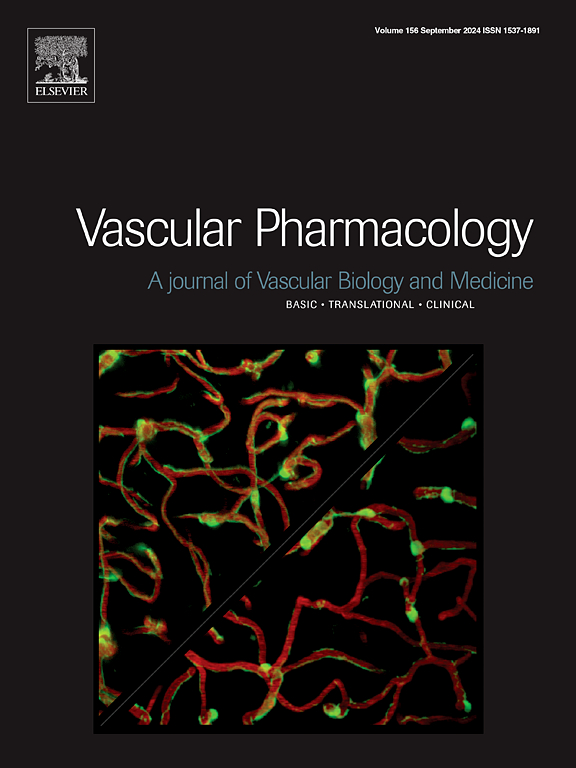Pharmacological activation of NO-sensitive guanylyl cyclase ameliorates obesity-induced arterial stiffness
IF 3.5
3区 医学
Q2 PHARMACOLOGY & PHARMACY
引用次数: 0
Abstract
Background & purpose
Arterial stiffness, or loss of elastic compliance in large arteries, is an independent precursor of cardiovascular disease (CVD) [1] and dementia [2] for which currently there are no targeted therapies. We previously discovered that decreases in NO-sensitive guanylyl cyclase (NO-GC), the NO receptor which synthesizes cGMP, and in its target vasodilator-stimulated phosphoprotein (pVASPS239), lead to increased cytoskeletal actin polymerization in vascular smooth muscle cells (VSMCs) contributing to increased arterial stiffness [3]. In the current study, we tested whether activating NO-GC with an NO-GC activator (cinaciguat) modulates pVASPS239 and cytoskeletal actin polymerization in VSMCs, thereby preventing obesity-induced arterial stiffness.
Experimental approach & key results
Cinaciguat administration (5 mg/kg) to high fat, high sucrose diet (HFHS)-fed mice, our established model of arterial stiffness [4], (1) decreased pulse wave velocity, the in vivo index of arterial stiffness, without affecting blood pressure; (2) increased aortic pVASPS239 levels; and (3) decreased actin polymerization, measured as ratio of filamentous (F) to globular (G) actin, compared to vehicle administration. In cultured VSMCs, cinaciguat (10 μmol/L) increased pVASPS239 levels and decreased the F/G actin ratio at baseline and after stimulation with the cytokine tumor necrosis factor α (TNFα), which we previously showed is significantly increased in the aorta of HFHS-fed mice [[4], [5], [6]]. These effects were abrogated in aortas and VSMCs from mice with smooth muscle-specific cGKI deletion (cGKISMKO), while being mimicked by a cell-permeable cGMP analog (8-Br-cGMP), which also decreased VSMC stiffness in vitro.
Conclusions & implications
Collectively, our data strongly support the notion that pharmacological NO-GC activation would be beneficial in decreasing obesity-associated arterial stiffness by decreasing VSMC cytoskeletal actin hyper-polymerization. If translated to humans, NO-GC activators could become a viable approach to clinically treat arterial stiffness, which remains an unmet medical need.

no敏感的guanyyl环化酶的药理激活改善肥胖引起的动脉僵硬。
背景与目的:动脉僵硬,或大动脉弹性顺应性丧失,是心血管疾病(CVD)[1]和痴呆[2]的独立前兆,目前尚无靶向治疗方法。我们之前发现,一氧化氮敏感的鸟酰环化酶(NO- gc)(合成cGMP的一氧化氮受体)及其靶血管扩张剂刺激磷酸化蛋白(pVASPS239)的减少,导致血管平滑肌细胞(VSMCs)中细胞骨架肌动蛋白聚合增加,从而增加动脉僵硬度[3]。在当前的研究中,我们测试了用NO-GC激活剂(cinaciguat)激活NO-GC是否可以调节VSMCs中的pVASPS239和细胞骨架肌动蛋白聚合,从而预防肥胖引起的动脉硬化。实验方法与关键结果:给药5 mg/kg高脂高糖饮食(HFHS)小鼠,建立动脉硬化模型[4],(1)降低脉搏波速度,动脉硬化在体指标,不影响血压;(2)主动脉pVASPS239水平升高;(3)与给药相比,肌动蛋白聚合减少,以丝状(F)与球状(G)肌动蛋白的比例来衡量。在培养的VSMCs中,cinaciguat(10 μmol/L)在基线和细胞因子肿瘤坏死因子α (TNFα)刺激后增加pVASPS239水平,降低F/G肌动蛋白比率,我们之前发现在hfhs喂养的小鼠主动脉中,TNFα显著增加[4-6]。这些影响在平滑肌特异性cGKI缺失(cGKISMKO)小鼠的主动脉和VSMC中被消除,而细胞渗透性cGMP类似物(8-Br-cGMP, 1 μmol/L)也能降低体外VSMC的硬度。结论和意义:总的来说,我们的数据强烈支持这样一种观点,即通过降低VSMC细胞骨架肌动蛋白超聚合,药理NO-GC激活将有利于降低肥胖相关的动脉僵硬。如果转化为人类,NO-GC激活剂可能成为临床治疗动脉僵硬的可行方法,这仍然是一个未满足的医疗需求。
本文章由计算机程序翻译,如有差异,请以英文原文为准。
求助全文
约1分钟内获得全文
求助全文
来源期刊

Vascular pharmacology
医学-药学
CiteScore
6.60
自引率
2.50%
发文量
153
审稿时长
31 days
期刊介绍:
Vascular Pharmacology publishes papers, which contains results of all aspects of biology and pharmacology of the vascular system.
Papers are encouraged in basic, translational and clinical aspects of Vascular Biology and Pharmacology, utilizing approaches ranging from molecular biology to integrative physiology. All papers are in English.
The Journal publishes review articles which include vascular aspects of thrombosis, inflammation, cell signalling, atherosclerosis, and lipid metabolism.
 求助内容:
求助内容: 应助结果提醒方式:
应助结果提醒方式:


